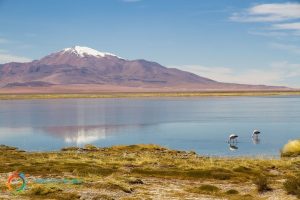Eclipse 2020: Its relevance for Astrotourism and the Indigenous Cosmovision
By: Chile Travel - 28 August, 2021

We are less than 100 days away from one of the most important events of 2020, especially for astrotourism. This coming December 14th, our country will once again witness a total solar eclipse. A magnificent event that will be seen in southern Chile and in particular in the areas of Biobío, Araucanía and Los Ríos, which will be able to see different phenomena of a total eclipse since they are within the dark strip covering from Isla Mocha in the north to Panguipulli in the south. The latter is the so-called “umbra”, that is, the area of total darkness, which on this occasion will have an extension of 110 kilometers.
A solar eclipse is when the moon passes between the earth and the sun, totally or partially obscuring the image and the light of the star that is projected onto the earth. A total eclipse occurs when the Moon’s apparent diameter is larger than the Sun’s, blocking the sunlight that directly reaches the Earth’s surface.
The astronomer and National Prize of Exact Sciences José Maza provides more details about the eclipse’s zones in an interview with CNN Chile: “There is an axis (the umbra’s center) that passes by the south of the Budi Lake (Araucanía), then it passes by the towns of Gorbea, Villarrica, Pucón and it should end in Carahue, near the mountain range. It is not a specific area, it’s a strip”.

Solar eclipse and ancient cultures.
Since ancient times, the Sun and the Moon have been significant elements in ancient cultures, since like the stars, they have been the explanation of the natural phenomena they have witnessed. The Sun is considered the father, a mystical hero, the center that makes the existence of light and germination possible. It is almost always accompanied by the Moon, its female companion, creating a family concept that makes the reproduction of life possible.
In the Mapuche culture they are Antü and Küyen and for the Aymara culture they are Inti and Killa. Although there is a legend for each culture, we find in common that the sky helped them to organize their own agricultural tasks and rituals.
As astronomer Daniela Palma points out: “The relevance of the Sun in nature was always obvious to the indigenous peoples: its power, light, and heat allowed them to have a series of practical knowledge that they applied during their daily lives”.
For the Aymara people, who inhabited parts of northern Chile, an eclipse represents a conflict between the stars, the Sun, and the Moon. Solar eclipses were known as “Lupi Nakjanti” or Burnt Sun.
For the Mapuche communities who live in the areas where the eclipse will be seen, the interpretation depends on and varies according to the perspective of each community. A solar eclipse is known as “Lan Antü” or “Lai Antü” and although there is a coincidence in that its meaning would mean “death of the sun”, it also known as “malonji ta antü”, that in English would translate as “they came to cover the sun or attack on the sun”.

For them it is a period of change that begins a new cycle. “The Sun and the Moon are elements that define time for the indigenous peoples, hence, describing the death of one of them implies that something stops, a cycle change of the star’s life. Within the context of death, it is strong because it is identified with a process change”, explains Dr. Elisa Loncón, an academic from the University of Santiago during an interview with the same university.
This ancestral culture has a special respect for these events since the sun represents a way of understanding time and the “death of the sun” implies a change of cycle for the star. Formerly a total eclipse created a lot of fear, which meant the organization of ritual ceremonies or “nguillatun” by the spiritual leaders called “machi” to reestablish the balance between the earth and the sun.
The historian, Mapuche researcher, Kimche and author of the book “Tayiñ Mapuche Kimün, Mapuche Epistemology: wisdom and knowledge” Juan Ñanculef states in an interview with Marca Chile that “A great Mapuche principle says that after the negative comes the positive. The indigenous people celebrated when the sun came out and the omen was that the weather was good”.
Hence, with the passing of the years and the new Mapuche cosmovision, the communities not only attribute this spiritual meaning to the eclipse, but also understand that it is a unique event of its kind that gives the area a tremendous opportunity to make its culture known and generate unique instances with the rest of Chile and the world.

Eclipses and astrotourism.
Our country’s privileged and unique geography has given us the purest skies on the planet, with more than 290 clear days and with environmental conditions practically free of light pollution, which is why more than 60 years ago, Chile was chosen to install observatories with the highest technological advances. For these reason, Chile has been given a differentiated strategic approach to develop astronomical tourism or astrotourism.
Pablo Álvarez, director of “Verde”, the consulting firm in charge of implementing astrotourism in Chile, during an interview with Planetarium explains that our country is committed to a long-term leadership in this area, with the objective of becoming an outstanding international astrotourism destination.
But what is astrotourism? It is all the recreational and/or educational activities developed around an astronomical phenomena and the ways to understand them. In our country, astrotourism experiences can be found from daily visits to international scientific observatories, outdoor excursions to observe the night sky with the “naked eye” or with technology; specialized hotels and restaurants, astronomy and astrophotography courses, visits to tourist centers such as observatories, museums, and planetariums.
The eclipse season, which greatly boosts astrotourism, began in July 2019, 450 kilometers from Santiago, in the regions of Atacama and Coquimbo. Both areas are renowned for their large international telescopes, located at the peaks of their hills that had not witnessed a total solar eclipse for 427 years.
Chilean astronomer Mario Hamuy commented on this phenomenon in an interview with T13: “This is probably the most important popular astronomical phenomenon of the last few years and one that will take place in Diaguita lands. It is an opportunity to see a phenomenon that nature gives us and the Coquimbanos and Serenians will see this shadow of the Moon that will pass over their homes. The next phenomenon of this type will occur in the region in the year 2075”.
Regarding the next eclipse in the Araucanía, Hamuy, during an interview with the newspaper La Tercera, explains that “For astronomers this is a great opportunity to bring science closer to citizens and to reveal the cosmological knowledge of our ancestral peoples”.
José Maza agrees concluding that “the total eclipse of Villarrica and Pucón will last two minutes and nine seconds, being the last event of this type, since between the years 2021 and 2040 no other total eclipse of the sun is foreseen for our country.”
A must-see for the scientific community and for all astrotourism fans, which will be preceded by the Geminids meteor shower that will take place on the nights of December 12 and 13, starting a fascinating day of astronomical events.

Photo Credits
Benjamín Briones Grandi


















